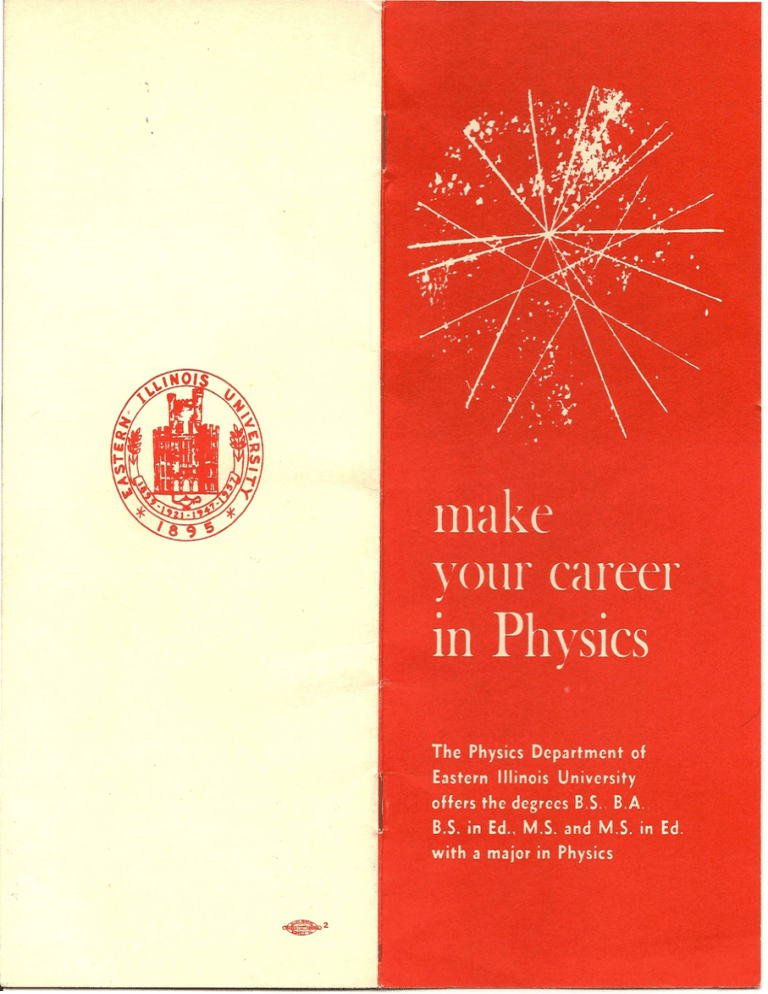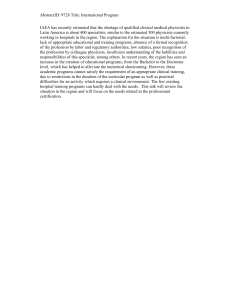1969-1970 EIU Physics recruitment brochure
advertisement

Research grade X-Ray facilities are available. What Do Physicists Do? 'When one hears of the success of the latest satellite or of a new advance in communications, or of people gaining a better understanding of the nature of the atom, it is almost certain that the scientists in the forefront of that advance of knowledge are physicists. Physicists are curious people trying to learn nature's secrets. Of course, as one learns more, it becomes necessary to concentrate one's efforts in certain areas. Theoretical physicists use mathematical tools to interpret-the results of experiments, and they also suggest new theories of nature's behavior. Experimental physicists devise laboratory measurements that can test the theories that have been proposed and obtain £acts that can be used as a basis for more advanced theories. Another classification of physicists is by their area of specialization, i.e., as astro, solidstate, nuclear, high-energy, bio or low-temperature, etc., physicists. And, of course, we could group physicists as being in teaching or in research (or both), in industry (the rocket people employ many physicists), or in government work (the National Aeronautics and Space Administration, the National Bureau of Standards or perhaps the Atomic Energy Commission). Many employers are beginning to realize that people with the broad basic background of the physicist can understand better than specialists the complexities of modern technology. Physicists are now doing much of the ,work formerly done by electrical, aeronautical, mechanical, etc., engineers. Many physicists are employed as teachers. They teach in high schools, colleges, and universities. Many large industries have "on the job" training programs in which education in physics plays an important part. The basic understanding of Nature gained by physicists and other scientists will surely provide the insight necessary to solve the problems of our environment. Pollution, waste disposal and disturbed ecology require more scientific knowledge, not less, to be effectively handled. There is a continuing need for more physicists especially at the bachelor's degree level. While at the present time there is less demand for Ph.D. physicists than previously, the longterm need is a real one. What1s Due Physicists? The salaries paid naturally vary greatly, being dependent upon the background and ability of the person, and on the job. Broadly speaking, the beginning person with a BachLet's measure atomic energy levels. elor's degree will start at approximately $800 to $900 per month while physicists with the Ph.D. are on the average the highest paid scientists in the country. Usually beginning salaries per month in industry will be the same as those in teaching; however, the potential industrial wage usually is greater. Often scientists are in a position to advance into executive positions in major companies at quite high salaries. Why Come to Eastern? Most of the students considering physics as a career are quite capable people who are interested in why nature behaves as it does. To The physics department staff is: W. A. Butler, Head of the Department, Ph.D., atomic physics, University of Illinois, 1952. M. L. Breig, Ph.D., solid state physics, University of Oklahoma, 1963. William Cloud, Ph.D., atomic physics, University of Wisconsin, 1955. A. D. Davis, Ph.D., theoretical physics, University of California, Los Angeles, 1970. S. L. Eisenhour, Ph.D., solid state physics, University of Illinois, 1962. G. Q. Lefler, Ph.D., Professor Emeritus, Indiana University, 1936. P. S. Smith, Ph.D., theoretical physics, Cornell University, 1951. R. C. Waddell, Ph.D., nuclear physics, Iowa State University, 1955. Erwin A. Whalin, Jr., Ph.D., nuclear physics, University of Illinois, 1954. Paul F. Ruddell, M.S., Purdue University, 1966. Maurice D. Shepherd, M.S., Indiana University, 1967. H. A. Taitt, M.S. (on leave 1970-71), University of Delaware, 1959. L. R. Gibson, M.S., Ohio University, 1970. Charles E. Miller, Jr., B.S.Ed., Faculty Assistant, Eastern Illinois University, 1963. The physics department offers the undergraduate physics major a choice of the degrees B.A., B.S., and B.S. in Ed., while at the graduate level the M.S. and M.S. in Ed., are available. Courses offered at the undergraduate level include general physics, optics, classical mechanics, electronics, electricity and magnetism, atomic, quantum mechanics, nuclear, solid state, thermodynamics, experimental physics laboratory, and independent study. The text books used are written by authorities in their respective fields and are the same as those adopted by many leading universities of the nation. In addition to work in this department, each physics major is expected to take approximately three years' work in mathematics. Courses available include computer programming, calculus, differential equations, advanced calculus, and matrix algebra. At the higher levels the distinction between work in theoretical physics and applied mathematics becomes slight. The department sponsors a local student section of the A.J.P. and a chapter of the national physics honor society, ~II~. Adequate equipment is available for experimental work in many areas of modern and classical physics. Much equipment is built up 4: 5 them, "Why come to Eastern?" is a reasonable question. The': program in physics, and in related mathematics, at Eastern Illinois University is strong. ~ wide range of courses, taught by professors of ability, experience, and possessing Ph.D.'s in physics, is available. Class size is kept to a minimum in order that student-professor contacts are easily made and to permit ample opportunity for questions and class discussion. Yet Eastern, with a 1970 enrollment of approximately 8400, is not a small school. There are many students with similar interests and abilities. Eastern's physics graduates are readily accepted into the communities of scholars of the well-known graduate schools, into the ranks of industry, and into the teaching profession. In addition to taking a strong science program, opportunities for study in the areas of literature, philosophy, language, music, and art help make the physics graduate a broadly-educated person. Before choosing any college or university, the able student should carefully investigate the size of its classes, the education of its professors, the laboratory equipment available, the standard of quality of each course, and whether his classes will be taught hy graduate students or by professors. Eastern's Physics Program Making a direct measurement of the speed of light. The calculation of microwave frequencies phun. is In the last few years over 100 people have graduated with a major in physics from this department. Many are teaching, others are employed in industry and government research while others are in graduate schools across the nation. At the present time Eastern physics graduates are working on or have recently obtained the Ph.D. from such schools as the University of Illinois, University of Alabama, University of Kentucky, Ohio University, University of Southern California, Iowa State University, Michigan State University, University of Wisconsin. In industry, graduates of the last few years include employees of Hughes Aircraft, 'Westinghouse, Wright Air Development Center, Litton Industries, McDonnell Aircraft, International Telephone and Telegraph, Mallory Electric Company, Convair, General Electric Company, Livermore Research Laboratory, 'Western Electric, and many others. Eastern physics graduates are now, or have recently been, faculty members or assistants at several major universities including the University of Southern California, University of Illinois, University of Missouri at Rolla, Virginia Polytechnic Institute, and South Dakota School of Mines. Junior college physics instructors also can get their training at Eastern-for example the instructors of Lake Land, Olney, and Sauk Valley Junior Colleges are Eastern graduates. Many other Eastern graduates teach physics in the high schools of Illinois and the nation. An area sample in- 6 7 Research in biophysics. and maintained through the services of a fulltime 'shop man. While the space available to physics was doubled in 1965, planning is now underway for another major expansion of the physics facilities. This increase will greatly improve opportunities for research in several areas of modern physics. Where Are Eastern's Graduates Employed? dudes the physics teachers of high schools in Champaign, Danville, Mattoon, Decatur, and Shelbyville. For complete injormation , COil tact: Dr. W. A. Butler, Head Physics Department Eastern Illinois University Charleston, Illinois 61920 or If you desire a University catalog and admission material, write to: Director of Admissions Eastern Illinois University Charles ton, Illinois 61920 Of course, you are welcome to visit Eastern and its physics department at any time. You may sit in on a few classes, meet staff members, and talk to students. Come to Eastern Illinois University to study physics. Modern electronic equipment for the classroom demonstration.
